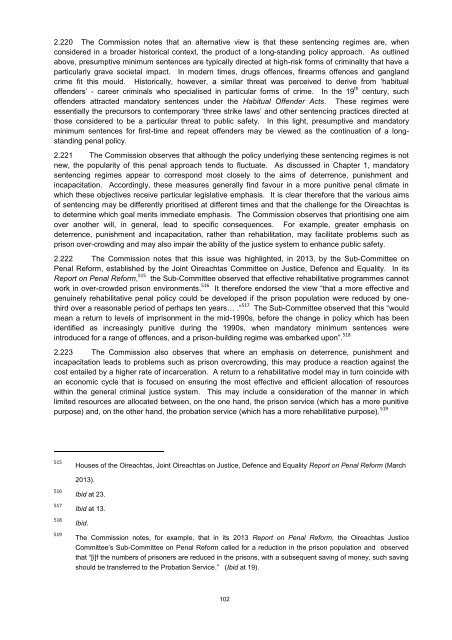Report on Mandatory Sentences - Law Reform Commission
Report on Mandatory Sentences - Law Reform Commission
Report on Mandatory Sentences - Law Reform Commission
Create successful ePaper yourself
Turn your PDF publications into a flip-book with our unique Google optimized e-Paper software.
2.220 The Commissi<strong>on</strong> notes that an alternative view is that these sentencing regimes are, when<br />
c<strong>on</strong>sidered in a broader historical c<strong>on</strong>text, the product of a l<strong>on</strong>g-standing policy approach. As outlined<br />
above, presumptive minimum sentences are typically directed at high-risk forms of criminality that have a<br />
particularly grave societal impact. In modern times, drugs offences, firearms offences and gangland<br />
crime fit this mould. Historically, however, a similar threat was perceived to derive from ‘habitual<br />
offenders’ - career criminals who specialised in particular forms of crime. In the 19 th century, such<br />
offenders attracted mandatory sentences under the Habitual Offender Acts. These regimes were<br />
essentially the precursors to c<strong>on</strong>temporary ‘three strike laws’ and other sentencing practices directed at<br />
those c<strong>on</strong>sidered to be a particular threat to public safety. In this light, presumptive and mandatory<br />
minimum sentences for first-time and repeat offenders may be viewed as the c<strong>on</strong>tinuati<strong>on</strong> of a l<strong>on</strong>gstanding<br />
penal policy.<br />
2.221 The Commissi<strong>on</strong> observes that although the policy underlying these sentencing regimes is not<br />
new, the popularity of this penal approach tends to fluctuate. As discussed in Chapter 1, mandatory<br />
sentencing regimes appear to corresp<strong>on</strong>d most closely to the aims of deterrence, punishment and<br />
incapacitati<strong>on</strong>. Accordingly, these measures generally find favour in a more punitive penal climate in<br />
which these objectives receive particular legislative emphasis. It is clear therefore that the various aims<br />
of sentencing may be differently prioritised at different times and that the challenge for the Oireachtas is<br />
to determine which goal merits immediate emphasis. The Commissi<strong>on</strong> observes that prioritising <strong>on</strong>e aim<br />
over another will, in general, lead to specific c<strong>on</strong>sequences. For example, greater emphasis <strong>on</strong><br />
deterrence, punishment and incapacitati<strong>on</strong>, rather than rehabilitati<strong>on</strong>, may facilitate problems such as<br />
pris<strong>on</strong> over-crowding and may also impair the ability of the justice system to enhance public safety.<br />
2.222 The Commissi<strong>on</strong> notes that this issue was highlighted, in 2013, by the Sub-Committee <strong>on</strong><br />
Penal <strong>Reform</strong>, established by the Joint Oireachtas Committee <strong>on</strong> Justice, Defence and Equality. In its<br />
<str<strong>on</strong>g>Report</str<strong>on</strong>g> <strong>on</strong> Penal <strong>Reform</strong>, 515 the Sub-Committee observed that effective rehabilitative programmes cannot<br />
work in over-crowded pris<strong>on</strong> envir<strong>on</strong>ments. 516 It therefore endorsed the view “that a more effective and<br />
genuinely rehabilitative penal policy could be developed if the pris<strong>on</strong> populati<strong>on</strong> were reduced by <strong>on</strong>ethird<br />
over a reas<strong>on</strong>able period of perhaps ten years… .” 517 The Sub-Committee observed that this “would<br />
mean a return to levels of impris<strong>on</strong>ment in the mid-1990s, before the change in policy which has been<br />
identified as increasingly punitive during the 1990s, when mandatory minimum sentences were<br />
introduced for a range of offences, and a pris<strong>on</strong>-building regime was embarked up<strong>on</strong>”. 518<br />
2.223 The Commissi<strong>on</strong> also observes that where an emphasis <strong>on</strong> deterrence, punishment and<br />
incapacitati<strong>on</strong> leads to problems such as pris<strong>on</strong> overcrowding, this may produce a reacti<strong>on</strong> against the<br />
cost entailed by a higher rate of incarcerati<strong>on</strong>. A return to a rehabilitative model may in turn coincide with<br />
an ec<strong>on</strong>omic cycle that is focused <strong>on</strong> ensuring the most effective and efficient allocati<strong>on</strong> of resources<br />
within the general criminal justice system. This may include a c<strong>on</strong>siderati<strong>on</strong> of the manner in which<br />
limited resources are allocated between, <strong>on</strong> the <strong>on</strong>e hand, the pris<strong>on</strong> service (which has a more punitive<br />
purpose) and, <strong>on</strong> the other hand, the probati<strong>on</strong> service (which has a more rehabilitative purpose). 519<br />
515<br />
Houses of the Oireachtas, Joint Oireachtas <strong>on</strong> Justice, Defence and Equality <str<strong>on</strong>g>Report</str<strong>on</strong>g> <strong>on</strong> Penal <strong>Reform</strong> (March<br />
2013).<br />
516<br />
517<br />
518<br />
519<br />
Ibid at 23.<br />
Ibid at 13.<br />
Ibid.<br />
The Commissi<strong>on</strong> notes, for example, that in its 2013 <str<strong>on</strong>g>Report</str<strong>on</strong>g> <strong>on</strong> Penal <strong>Reform</strong>, the Oireachtas Justice<br />
Committee’s Sub-Committee <strong>on</strong> Penal <strong>Reform</strong> called for a reducti<strong>on</strong> in the pris<strong>on</strong> populati<strong>on</strong> and observed<br />
that “[i]f the numbers of pris<strong>on</strong>ers are reduced in the pris<strong>on</strong>s, with a subsequent saving of m<strong>on</strong>ey, such saving<br />
should be transferred to the Probati<strong>on</strong> Service.” (Ibid at 19).<br />
102
















